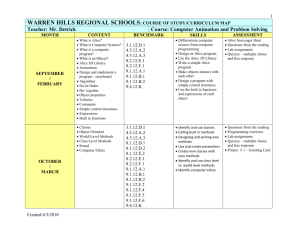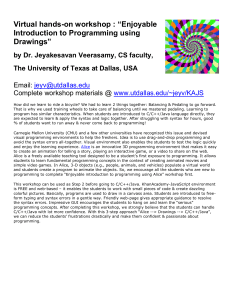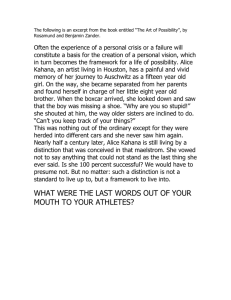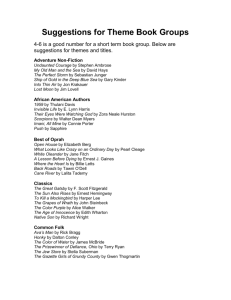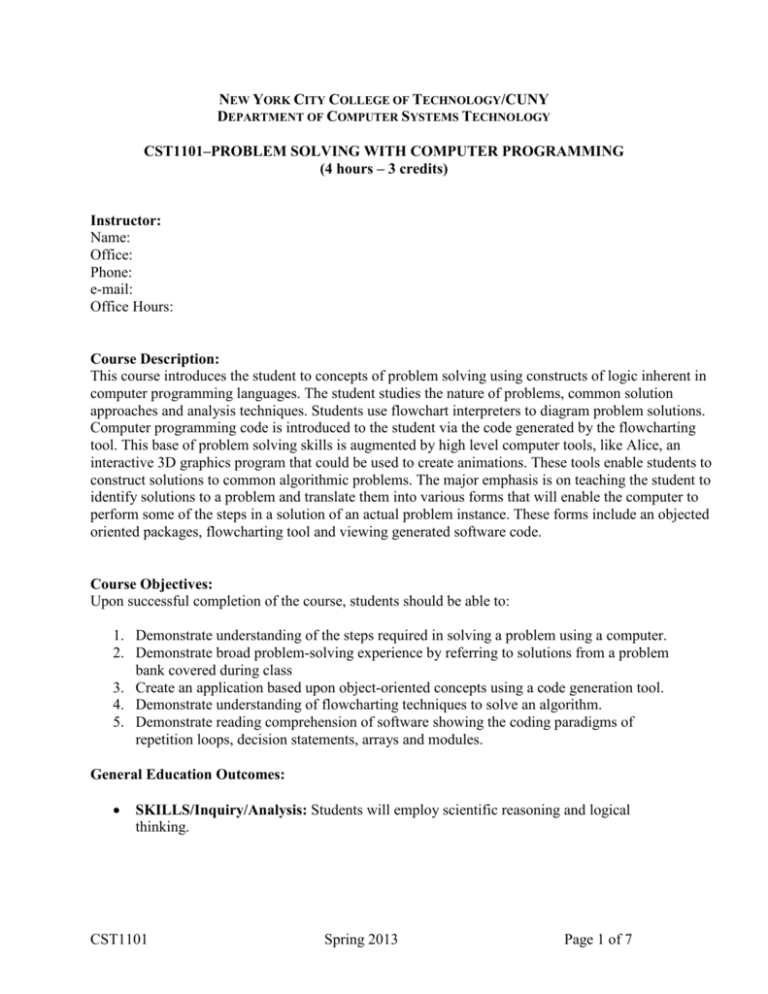
NEW YORK CITY COLLEGE OF TECHNOLOGY/CUNY
DEPARTMENT OF COMPUTER SYSTEMS TECHNOLOGY
CST1101–PROBLEM SOLVING WITH COMPUTER PROGRAMMING
(4 hours – 3 credits)
Instructor:
Name:
Office:
Phone:
e-mail:
Office Hours:
Course Description:
This course introduces the student to concepts of problem solving using constructs of logic inherent in
computer programming languages. The student studies the nature of problems, common solution
approaches and analysis techniques. Students use flowchart interpreters to diagram problem solutions.
Computer programming code is introduced to the student via the code generated by the flowcharting
tool. This base of problem solving skills is augmented by high level computer tools, like Alice, an
interactive 3D graphics program that could be used to create animations. These tools enable students to
construct solutions to common algorithmic problems. The major emphasis is on teaching the student to
identify solutions to a problem and translate them into various forms that will enable the computer to
perform some of the steps in a solution of an actual problem instance. These forms include an objected
oriented packages, flowcharting tool and viewing generated software code.
Course Objectives:
Upon successful completion of the course, students should be able to:
1. Demonstrate understanding of the steps required in solving a problem using a computer.
2. Demonstrate broad problem-solving experience by referring to solutions from a problem
bank covered during class
3. Create an application based upon object-oriented concepts using a code generation tool.
4. Demonstrate understanding of flowcharting techniques to solve an algorithm.
5. Demonstrate reading comprehension of software showing the coding paradigms of
repetition loops, decision statements, arrays and modules.
General Education Outcomes:
•
SKILLS/Inquiry/Analysis: Students will employ scientific reasoning and logical
thinking.
CST1101
Spring 2013
Page 1 of 7
•
SKILLS/Communication: Students will communicate in diverse settings and groups,
using written (both reading and writing), oral (both speaking and listening), and visual
means
•
VALUES, ETHICS, RELATIONSHIPS / Professional/Personal Development:
Students will work with teams, including those of diverse composition. Build consensus.
Respect and use creativity.
Prerequisite – CUNY certification in mathematics, reading and writing. General knowledge of a
personal computer is needed. Students may enroll in a workshop at the Academic Learning Center,
located in the Atrium.
Required Textbooks - "Starting Out With ALICE: A Visual Introduction to Programming" by Tony
Gaddis. Pearson/Addison Wesley, 2nd edition, 2011
Recommended Web sites –
www.visuallogic.org Students can download, free of charge, the flowchart interpreter, Visual Logic,
which will be used through out the course.
www.pearsonhighered.com/gaddis This is the companion website for the required textbook. Students
will find useful resources at this site, like additional exercises and tests that complement the material in
the required textbook.
www.alice.org Students can download Alice from this site. Download is free of charge. The site also
contains a lot of information, tutorials, and forums on how to use Alice, which will be helpful for the
course project and Alice assignments.
Attendance – Attendance is expected at every class meeting. College policy sets the maximum number of
permissible absences at 10% of the number of class meetings scheduled for the semester. If the class is
meeting two times per week, you are permitted to be absent a total of three class sessions; if the class
meets only once per week, you are permitted to miss one and one-half of the class meetings.
Academic Integrity – Students and all others who work with information, ideas, texts, images,
music, inventions, and other intellectual property owe their audience and sources accuracy and
honesty in using, crediting, and citing sources. As a community of intellectual and professional
workers, the College recognizes its responsibility for providing instruction in information
literacy and academic integrity, offering models of good practice, and responding vigilantly and
appropriately to infractions of academic integrity. Accordingly, academic dishonesty is
prohibited in The City University of New York and at New York City College of Technology
and is punishable by penalties, including failing grades, suspension, and expulsion. The complete
text of the College policy on Academic Integrity may be found in the catalog.
Grade Requirement – Students must complete all Lab and Online assignments, and take all tests.
CST1101
Spring 2013
Page 2 of 7
Evaluation and Grading –
Test1
Test2
Lab Assignments
Final
Project
Total
15%
15%
20%
20%
30%
=====
100%
Grade System: Numerical Grade Ranges
93-100
90-92.9
87-89.9
83-86.9
80-82.9
77-79.9
70-76.9
60-69.9
59.9 and below
Letter Grade
A
AB+
B
BC+
C
D
F
Storage Media -- You must have a USB storage media.
Project:
In the course project, students will develop a videogame prototype. This is a group project in which
students will use ALICE (www.alice.org), a free interactive 3D graphics program to create animations. In
a term paper students will describe the story of the game and how it was implemented with Alice. Each
team will present to the class their work. The following are the project milestones.
1)
2)
3)
4)
Create a setting for the videogame
Create characters (protagonist and antagonist) for the videogame
Integrate videogame setting and characters
Implement the characters interactions among themselves and with their world (the
story)
5) Develop individually a character side-quest within the videogame developed by the
group
6) Integrate the main story and side-quest
COURSE OUTLINE
Topics/Assignments
CST1101
Spring 2013
Page 3 of 7
Meeting Date
1
2
3
4
5
6
7
8
9
10
11
12
13
14
CST1101
Topic to be Covered
Assignments
Discussion of general problem
solving methods. Introduction
to logical step solutions
Review of functions and their
use in logical solutions
Writing specific steps of
algorithms – English
pseudocode – decision making,
logical operators,
IF/THEN/ELSE
Using repetition, with WHILE
loops and FOR/NEXT loops
Introduction to Flowcharting:
Sample Visual Logic program
(Visual Logic User’s
Guide(VLUG)/Lesson 1)
Input / Output and arithmetic
operators with Visual Logic
(VLUG/Lesson 2,Lesson 3)
Selection structures, conditional
and logical operators with
Visual Logic (VLUG/Lesson 4)
Repetition structures with
Visual Logic (VLUG/Lesson
5,Lesson 6)
Repetition structures with
Visual Logic (VLUG/Lesson
7,Lesson 8)
TEST1 (60 min)
Introduction to Alice and
Objects
(Alice/Chapter 1)
Introduction to Alice and
Objects
(Alice/Chapter 1)(cont.)
Programming in Alice
(Alice/Chapter 2)
Programming in Alice
(Alice/Chapter 2) (cont.)
Variables and Functions
(Alice/Chapter 3)
Spring 2013
Page 4 of 7
15
16
17
18
19
20
21
22
23
24
25
26
27
Variables and Functions
(Alice/Chapter 3) (cont.)
Decision and Repetition
(Alice/Chapter 4)
Decision and Repetition
(Alice/Chapter 4) (cont.)
Methods, Functions
(Alice/Chapter 5)
Project work
Methods, Functions
(Alice/Chapter 5) (cont.)
Events
(Alice/Chapter 6)
TEST 2 (60 min)
Events
(Alice/Chapter 6) (cont.)
Lists and Arrays (Alice/Chapter
7)
The Java Environment – Using
the NetBeans IDE
Classes and objects in Java
Classes and objects in Java
(cont.)
Java programs and applications
29
Java language fundamentals
Project Presentations
Java language fundamentals
(cont.)
Review for the Final
30
Final
28
Assessment Criteria
For the successful completion of this
course a student should be able to:
CST1101
Evaluation methods and criteria
Spring 2013
Page 5 of 7
1. Demonstrate understanding of the steps
required in solving a problem using a
computer.
2. Demonstrate broad problem-solving
experience by referring to solutions from a
problem bank covered during class
3. Create an application based upon objectoriented concepts using a code generation
tool.
4. Demonstrate understanding of
flowcharting techniques to solve an
algorithm.
Students will describe problem, identify
inputs, processes and desired outcomes in
laboratory assignments, class work and
tests.
Students will solve problems with the
flowchart interpreter Visual Logic in
laboratory assignments, class work and
tests.
Students will demonstrate problem-solving
ability in laboratory assignments, class
work and tests.
Students will use object-oriented
programming concepts to create a video
game prototype or animation with Alice in
laboratory assignments and the project.
Students will solve problems with Visual
Logic in Laboratory Assignments, Class
work and tests.
5. Demonstrate reading comprehension of
Students will identify coding paradigms in
software showing the coding paradigms of Laboratory Assignments, Class work and
repetition loops, decision statements, arrays tests
and modules.
General Education Outcomes and Assessment:
Learning Outcomes
SKILLS/Inquiry/Analysis Students will
employ scientific reasoning and logical
thinking.
Assessment Method
Students will describe problem, identify
inputs, processes and desired outcomes
in laboratory assignments, class work
and tests.
Students will solve problems with the
flowchart interpreter Visual Logic in
laboratory assignments, class work and
tests.
SKILLS/Communication
Students will communicate in diverse
CST1101
Students will identify coding paradigms
in Laboratory Assignments, Class work
and tests
Term paper in which students will
describe the Alice project and how it
Spring 2013
Page 6 of 7
settings and groups, using written (both
reading and writing), oral (both speaking
and listening), and visual means
VALUES, ETHICS, RELATIONSHIPS
/ Professional/Personal Development
Students will work with teams, including
those of diverse composition. Build
consensus. Respect and use creativity.
CST1101
was implemented with Alice.
Oral presentations of the Alice project
Alice project in which students will
work in groups, build consensus and
respect and use creativity
Spring 2013
Page 7 of 7




